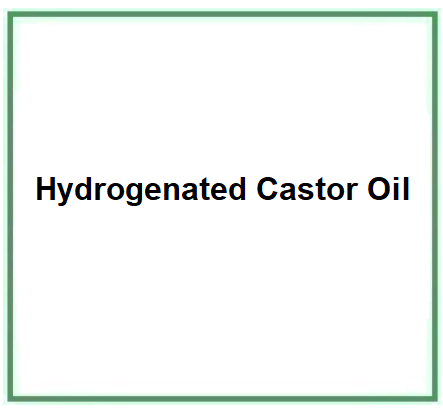Hydrogenated Castor Oil is a chemical compound, a castor oil that has undergone a hydrogenation process. Hydrogenation increases oxidative stability and raises the melting point, making the oil solid and more versatile for some applications, particularly cosmetics, plastics, and industrial lubricants.
The name describes the structure of the ingredient:
- "Hydrogenated" indicates that the oil has undergone a hydrogenation process, wherein hydrogen atoms are added to saturate the double bonds present in the triglycerides.
- "Castor Oil" refers to the oil extracted from the seeds of the Ricinus communis plant, commonly known as the castor plant.
Description of raw materials used in production:
- Castor Oil. Extracted from the seeds of the Ricinus communis plant.
- Hydrogen. Gas used in the hydrogenation process.
- Catalyst. Typically, a metal like nickel, which aids in hydrogenation.
Detailed summary of the production process.
- Extraction of Castor Oil. The oil is extracted from castor seeds via methods like cold pressing or solvent extraction.
- Oil Purification. Removing impurities and foreign substances.
- Hydrogenation. The castor oil is exposed to hydrogen in the presence of a metallic catalyst. This process adds hydrogen atoms to the unsaturated double bonds in the oil.
- Separation and Purification. Removal of the catalyst and any other impurities from the hydrogenated product.
- Packaging. The now-solid hydrogenated oil, termed Castor Wax, is packed and readied for sale or industrial use.
It appears as a yellow liquid.

What it is for and where
Cosmetics
Skin conditioning agent - Emollient. Emollients have the characteristic of enhancing the skin barrier through a source of exogenous lipids that adhere to the skin, improving barrier properties by filling gaps in intercorneocyte clusters to improve hydration while protecting against inflammation. In practice, they have the ability to create a barrier that prevents transepidermal water loss. Emollients are described as degreasing or refreshing additives that improve the lipid content of the upper layers of the skin by preventing degreasing and drying of the skin. The problem with emollients is that many have a strong lipophilic character and are identified as occlusive ingredients; they are oily and fatty materials that remain on the skin surface and reduce transepidermal water loss. In cosmetics, emollients and moisturisers are often considered synonymous with humectants and occlusives.
Surfactant - Emulsifying agent. Emulsions are thermodynamically unstable and are used to soothe or soften the skin and emulsify, so they need a specific, stabilising ingredient. This ingredient forms a film, lowers the surface tension and makes two immiscible liquids miscible. A very important factor affecting the stability of the emulsion is the amount of the emulsifying agent. Emulsifiers have the property of reducing the oil/water or water/oil interfacial tension, improving the stability of the emulsion and also directly influencing the stability, sensory properties and surface tension of sunscreens by modulating the filmometric performance.
Skin conditioning agent. It is the mainstay of topical skin treatment as it has the function of restoring, increasing or improving skin tolerance to external factors, including melanocyte tolerance. The most important function of the conditioning agent is to prevent skin dehydration, but the subject is rather complex and involves emollients and humectants that can be added in the formulation.
Surfactant - Cleansing agent. Cosmetic products used to cleanse the skin utilise the surface-active action that produces a lowering of the surface tension of the stratum corneum, facilitating the removal of dirt and impurities.
Viscosity control agent. It controls and adapts, Increasing or decreasing, viscosity to the required level for optimal chemical and physical stability of the product and dosage in gels, suspensions, emulsions, solutions.
Medical Applications
Laxatives. While traditional castor oil is often used as a laxative, the hydrogenated version generally doesn't possess this property.
Medicated Ointments and Creams. Hydrogenated castor oil can be used as a base for ointments and creams intended for treating various skin conditions.
Commercial applications
Cosmetics and Skin Care. Hydrogenated castor oil, often referred to as castor wax, is used as a thickening agent, emollient, and stabilizer in a range of skin care products.
Hair Care Products. This oil is used in conditioners, treatments, and hair styling products to impart softness and shine.
Makeup Products. Hydrogenated castor oil can be found in products like lipsticks and mascaras for its ability to provide consistency and enhance product hold.
Industry. Used as a lubricant and in the production of resins and plastics.
Safety
The CIR Expert Panel concluded that Hydrogenated Castor Oil as cosmetic ingredient is safe in the practices of use and concentrations as described in this safety assessment (1).
References_____________________________________________________________________
(1) Final report on the safety assessment of Ricinus Communis (Castor) Seed Oil, Hydrogenated Castor Oil, Glyceryl Ricinoleate, Glyceryl Ricinoleate SE, Ricinoleic Acid, Potassium Ricinoleate, Sodium Ricinoleate, Zinc Ricinoleate, Cetyl Ricinoleate, Ethyl Ricinoleate, Glycol Ricinoleate, Isopropyl Ricinoleate, Methyl Ricinoleate, and Octyldodecyl Ricinoleate. Int J Toxicol. 2007;26 Suppl 3:31-77. doi: 10.1080/10915810701663150.
![]() Hydrogenated Castor Oil
Hydrogenated Castor Oil 


